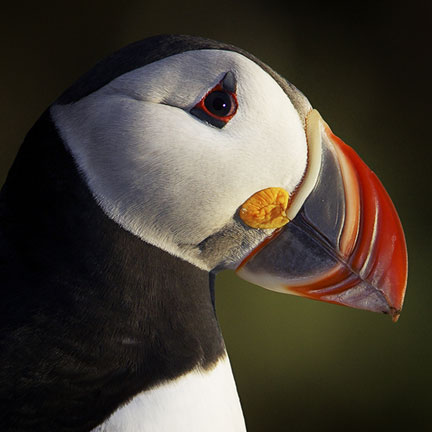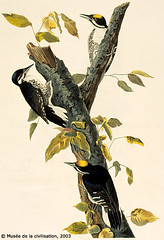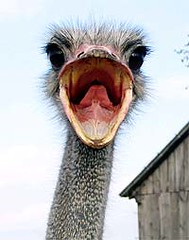Birds in the News #25 -- And Disaster Relief for Animals

Atlantic Puffin, Fratercula arctica.
Photograph by Fred Schang
Animal Disaster Relief:
I am unable to say anything useful regarding the terrible tragedy in Louisiana, Mississippi and nearby states, except to tell you that there is disaster relief available for pets and other captive animals in New Orleans, at least. The Louisiana Society for the Prevention of Cruelty to Animals (LA/SPCA), the Louisiana Veterinary Medical Association (LVMA) the Louisiana Animal Control Association (LACA), and the LSU School of Veterinary Medicine (SVM) are managing animal evacuations and recovery plans for New Orleans pets and animals displaced by hurricane Katrina. The LVMA is currently accepting pets at the Blackham Coliseum in Lafayette, LSU in Shreveport, the Monroe Civic Center for small animals and the Ike Hamilton Center for large animals in Monroe, the Farmer's Market in Alexandria, and the LSU Agriculture Center/Parker Coliseum in Baton Rouge. The Parker Coliseum will be staffed 24 hours per day with a supervising veterinarian and student volunteers from the LSU school of veterinary medicine. Residents who left pets in their homes may call a hot line to leave information about the number of animals, species, and their confined location (the number will be released to the media as soon as it is obtained). For anyone wishing to fund the care of hurricane-affected animals, financial donations are being accepted through the Dr. Walter J. Ernst, Jr. Veterinary Memorial Foundation at the LVMA at 1-800-928-LVMA.
The Humane Society (HSUS) is also rescuing animals from the hurricane-ravaged areas ("animals" include pets, horses, farm animals, zoo animals, and wildlife that were affected by Katrina and the floodwaters). The HSUS Disaster Animal Response Teams (DARTs) deployed immediately to the crisis, landing in Mississippi the day after Katrina did her damage. Now, teams are also ready to assist in Louisiana. But they face the awesome task of overcoming the fact that people are still in need of rescue and relief, that communications and transportation systems are in severe disrepair, and that the physical area affected is of enormous scope. “Katrina did not hit with surgical precision,” said Wayne Pacelle, president and CEO of The HSUS. “She laid waste to a huge swath of the Southeast, and it won’t be easy to pick up the pieces.” This linked article is long but is full of interesting news of rescued animals. You can also donate to the HSUS animal hurricane relief funds.
Birds in Science:
 Are forest fires always bad? Is there any value to be found in all that destruction? Apparently, there is a lot of value in recently burned forests for approximately 100 species, 15 of which are birds. In fact, some birds, such as the black-backed woodpecker, Picoides arcticus, flock to burned forest areas like moths to flames -- the blacker the better. "We found the severity issue is really interesting," said research scientist Richard Hutto. "Severity is a big, big deal. A fire is not a fire is not a fire. There are species that are very particular about what kind of fire they like." Western tanagers, Piranga ludoviciana, for instance, thrive in low-severity fires. Juncos, Junco species, prefer medium-severity burns. Black-backed woodpeckers, mountain bluebirds, Sialia currucoides, and olive-sided flycatchers, Contopus cooperi, like their forests well done. And the woodpeckers generally prefer thick-barked trees, ponderosa pine, Pinus ponderosa, and Douglas fir, Pseudotsuga menziesii, trees that withstand all but the hottest fires. (Pictured: A trio of black-backed woodpeckers by John James Audubon. Click on picture to see a larger image in its own window).
Are forest fires always bad? Is there any value to be found in all that destruction? Apparently, there is a lot of value in recently burned forests for approximately 100 species, 15 of which are birds. In fact, some birds, such as the black-backed woodpecker, Picoides arcticus, flock to burned forest areas like moths to flames -- the blacker the better. "We found the severity issue is really interesting," said research scientist Richard Hutto. "Severity is a big, big deal. A fire is not a fire is not a fire. There are species that are very particular about what kind of fire they like." Western tanagers, Piranga ludoviciana, for instance, thrive in low-severity fires. Juncos, Junco species, prefer medium-severity burns. Black-backed woodpeckers, mountain bluebirds, Sialia currucoides, and olive-sided flycatchers, Contopus cooperi, like their forests well done. And the woodpeckers generally prefer thick-barked trees, ponderosa pine, Pinus ponderosa, and Douglas fir, Pseudotsuga menziesii, trees that withstand all but the hottest fires. (Pictured: A trio of black-backed woodpeckers by John James Audubon. Click on picture to see a larger image in its own window).People Hurting Birds:
Some of the ways that people hurt birds is by introducing "alien" species into places where they don't belong. This is the case with the Altantic puffins, Fratercula arctica, (pictured at top), that live on islands in the Firth of Forth, Scotland. The birds are being forced from their burrows by alien plants introduced to these islands by lighthouse keepers, experts warned yesterday. The plant has wiped out 14,000 puffin burrows on one island, Craigleith, alone. However, Dr René van der Wal, a Centre for Ecology and Hydrology ecologist who is leading a three-year project into the problem for the Scottish Executive, said removing the plant would fail to solve the problem. "It is the huge seed bank that we need to find out about because it will just reappear if we cut it down and if we remove the plants completely the exposed soil will just wash away." David Kelly, the Lothian recorder for the Scottish Ornithology Club, said the plant was thriving in the guano and ammonia from the seabirds' faeces in the mouth of the burrows. "It is upsetting that puffins are basically digging their own graves by producing optimum conditions for the plant to take over their habitat," he said.
Of course, other people are more direct in their actions when they hurt birds. Close to my home, a young red-tailed hawk, Buteo jamaicensis, just learning to feed on her own, was shot down over a Queens (New York City) cemetery by a punk with a pellet gun. The hawk's wing was shattered, and she was found lying next to a tombstone. Animal Control Officer Katty Calderon said two adult hawks, most likely the parents of the 4-month-old bird, circled overhead while she tended to the stricken hawk. "Two bones in her wing were broken," said Bobby Horvath, who runs Wildlife in Need of Rescue and Rehabilitation in North Massapequa, Long Island. "They had to be surgically stabilized with a metal pin." But no one will know for another three months or so whether Ruby, as the hawk was christened by rescuers, will fly well enough to be released into the wild.
Six people were charged this past Monday with trafficking in protected species of migratory birds, including indigo buntings, Passerina cyanea, painted buntings, Passerina ciris, blue grosbeaks, Guiraca caerulea, and Northern cardinals, Cardinalis cardinalis. Among the suspects was Giraldo Wong, who prosecutors said was discovered with two Cuban grassquits, Tiaris canora, in his underwear at the Miami International Airport after he returned from Cuba in May.
A kiwi was stolen from Queenstown's Kiwi and Birdlife Park in New Zealand after a break-in at the popular tourist venture on the night of August 28th. The female bird was taken from her burrow and staff say she must have put up quite a fight, as feathers have been found scattered throughout the park.
People Helping Birds:
The Australian logging company, Forestry Tasmania, has extended the habitat for threatened swift parrots, Lathamus discolor, to increase protection of the birds after part of their habitat was mistakenly logged. Forestry Tasmania general manager Kim Creek says the error was caused by incorrect boundary markings on a map. Australia's political Green Party Senator Bob Brown says Forestry Tasmania has broken its own rules, and is calling for management to pay with their jobs. Swift parrots were the featured bird photo for Birds in the News #23.
Birds in the Media:
Featured this week on the popular radio show, BirdNote; Common Murre, Uria aalge, Fathers Take Over raising their chicks; the Common Murre, Underwater Flier; the Great Blue Heron, Ardea herodias, Alone Again; Birdsong Wanes with the Season; and the Amazing Aquatic American Dipper, Cinclus mexicanus. BirdNote shows are two-minute vignettes that incorporate the rich sounds of birds with stories that illustrate the interesting — and in some cases, truly amazing — abilities of birds. BirdNote can be heard Monday through Friday, 8:58-9:00AM, throughout Western Washington and Southwest British Columbia and is also available as RSS/Podcast feeds.
Avian Influenza News:
Inevitable. Remote or low. Small but real. Slight but serious. Even the experts are divided over whether we are on the brink of disaster from avian influenza. While the EU and British government were playing down the risks recently, some scientists were insisting the question was more one of 'when' than 'if'. Dr Bob McCracken, president of the British Veterinary Association, said: "Wild birds that have migratory pathways over Europe and the UK will become infected. It is inevitable that bird flu will be carried to this country." But some scientists believe migratory birds infected with H5N1 - the most virulent strain of avian flu - will die en route, long before they reach the EU. Additionally, people must be in close contact with live, ill birds before they themselves become ill with avian influenza. For example, Vietnam, where peasant farmers often live close to their livestock, is the worst-affected country in the world.
Alaska is viewed as the conduit through which avian influenza could reach North America by infecting migratory birds returning from their tundra nesting grounds. Bird experts working in some of the most remote areas of Alaska have begun checking migrating birds for avian influenza to see if they are spreading the feared virus out of Asia. A team heads off later this week for the Alaskan Peninsula to test Steller's eiders, Polysticta stelleri, an arctic seaduck species, for the virus, US Geological Survey experts said. Other teams have already begun testing geese and ducks in other refuges, taking advantage of regular ecological studies to test birds migrating from Asia for the H5N1 virus.
A wide range of wildlife species could be at risk from bird flu, warns a biologist from the University of East Anglia. Dr Diana Bell, of UEA's School of Biological Sciences, says the discovery that avian flu was responsible for the death of three rare civet cats in Cuc Phuong National Park in Vietnam, raises important questions about the range of wildlife species which could now be at risk from this virus. "Vietnam and the other Asian countries chronically infected with avian flu are biodiversity hotspots rich in species, many only occuring in this region," says Dr Bell, whose team has been working with the Vietnamese government, the World Health Organisation and the University of Hong Kong to confirm the cause of death in the endangered Owston's palm civets, Cynogale bennettii.
Ivory-billed Woodpecker News:
Does it live, or does it not? When a four-second snippet of video showing a black and white blur in flight was shown to an auditorium full of ornithologists here, it drew a collective "Ahhh!" - a murmur of awe seldom heard at scientific meetings. But this wasn't just any blurry video. This "ornithological Zapruder film," as one researcher called it, gives a glimpse of the much-mythologized ivory-billed woodpecker, Campephilus principalis, sought for a half-century, thought extinct and - just in the past two years - rediscovered, doubted and accepted again, primarily based on the strength of audio recordings. Is it time to start wearing an ivory-bill T-shirt (one version says, "found!"), or should the celebration wait? Is the $10 million for preservation of the bird's habitat going to explode? GrrlScientist note: I wear an IBWO t-shirt that says "Found!" It gets many admiring looks on the streets of Manhattan. What I am trying to say is that habitat preservation in that area is never wasted, whether the bird lives or not.
Miscellaneous Bird News:
Two of Warwickshire's (UK) rudest birds have been put into therapy for their delinquent ways. Pippa the sulphur-crested cockatoo, Cacatua sulphurea, and Barney the blue and gold macaw, Ara ararauna, (mentioned in previous issues of Birds in the News) have been hauled up before television vet Trude Mostue in an attempt to dissuade them from their deviant ways. Barney's language is as blue as his feathers, having sworn at a number of pillars of society including the vicar, a mayor, and a couple of policemen. Meanwhile, Pippa the cockatoo, who should actually be called Pip after learning late in life that she is actually a he, is a man-hater. The birds' encounter with Trude Mostue can be seen on Britain's Worst Pets on the Animal Planet channel.

A few days ago, San Francisco commuters were greeted by the sight of an ostrich, Struthio camelus, running around on the Golden Gate Bridge during rush hour. Ron Love, owner of Love Farms, was transporting two of the large birds in the back of his minivan. Love was stopped in traffic when he suddenly accelerated, jolting one of the ostriches, who smashed through the back window of the van and got loose on the bridge. After its adventure, the bird was recaptured without serious injuries.
Thanks to my bird pals, Ron and Karen, for several of the links you are enjoying here.
Note: this issue of Birds in the News was honored by a reader nomination for inclusion in the blog carnival Blogarithmicly #2. Blogarithmicly is a blog carnival that lists essays, essay-series or so-called "link harvests" (as this is) that provide extensive knowledge and linkage on single narrow topics.
Previous : : Birds in the News : : Next
Included with the Blogarithmicly Carnival
Issue 2.
Non-Academic Job Applications: 1 (Manager of a Genetics Analysis Facility)
© 2004, 2005, 2006 by GrrlScientist











6 Peer Reviews:
Several comments for this blog. First, I just love puffins. I had a favorite children's book about puffins when I was little and the fascination with this bird has stayed with me. Second, I was glad to read about the animal rescue efforts. I saw several new clips where people were forced to leave their animals behind. And, finally, you need to get a job as a free lance writer as a suppliment to your income!!
thought you might be interested to know that right after katrina hit there were tons of brown pelicans either dead or injured along interstate 10 across mobile bay. they had sought refuge on the bridge because it was one of the few structures in the area that wasn't quite completely under water. it was a very disturbing sight. animal control rescue teams were sent to help the injured pelicans as soon as they could.
For animal rescue, don't overlook Noah's Wish. It is a group that is dedicated only to helping animals in disaster. They do not work on any other issues, just rescuing in disasters.
As for the puffins losing ground to tree mallow, if they want volunteers to go wander the shores of Scottish islands, I'd be glad to go help out until the end of my natural life. Scotland is simply the most beautiful place in the world, and the people are wonderful.
And, um, that guy with the birds in his underwear? He didn't think anyone would notice something a little, you know, abnormal down there?
FYI, PBS is re-airing the episode of Nature on Pale Male next Sunday, Sept. 11.
Tabor; I am happy to satisfy your affections for puffins. I was hoping that lots of people would find them visually appealing enough to read the story about them, but alas, I think I was wrong.
Latina Marie; oh, I am so sad to know this about brown pelicans! I hope the survivors are being given adequate veterinary attention to survive!
C. corax; thanks for the link to the animal rescue agency. Incidentally, you are defending your dissertation soon, aren't you? If so, it seems that a vacation to Scotland is in order for you.
Jamie; ah, that's good to know, thanks for posting that. I saw that special show about Pale Male and loved it. I am glad to know it's being shown again.
GrrlScientist
it was an aquarium in gulfport, MS that moved its dolphins to the pools of two different hotels in the same city but further inland. one was a best western. i don't remember what the other hotel was.
Post a Comment
<< Home